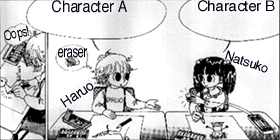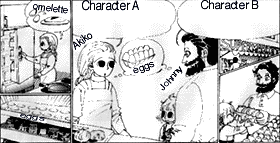|
|
EFL
Japan "a world of difference" |
|
|
|
||
|
|
EFL
Japan "a world of difference" |
|
|
|
||
| The pic-word format is especially effective if we want to teach illocutionary or implicit use of language, such as getting someone to do something. In illocutionary usage, the meaning of a proposition is not to be understood literally. The interlocutors, however, share a common knowledge of a situation, as is clear from Games 6 and 7. |
|
|
||
| Conversational
Focus Haruo needs an eraser but he doesn't have one ... 消しゴムを持ってこなかったハルオは隣の席のナツコに借りる。 |
Communication
Function CharacterA / CharacterB Making a request to borrow something (ex. an eraser) /Agreeing to the request (消しゴムを)貸してくれるよう頼む/頼みに応じる |
Character A / Character B 1. I forgot my eraser ... /Oh, I'll lend you mine. 2. I don't have an eraser ... /No problem. Use mine. |
 |
||
|
|
||
| Conversational
Focus Akiko wants Johnny to get some eggs from the store because there isn't a single egg in the refrigerator ... 冷蔵庫に卵がない。アキコがジョニーに買って来てくれるよう頼む |
Communication
Function CharacterA / CharacterB Asking someone to go and buy something (ex. eggs) /Agreeing 買い物を頼むには?(ここでは卵)/応じるなら? |
Character A / Character B 1. We are out of eggs ... /Okay, I'll go get some. 2. Guess what ...? There are
no eggs in the house ... |
 |
||
| While it is true conversations do not usually
end with one or two exchanges, it is equally true that when it
comes to explaining conversational usage in particular situations,
we are invariably talking about a single word, phrase, or sentence
rather than a string of sentences. Since less is more in this
"minimalist" approach in which conversational settings
are communicated through pictures and words, it is logical that
the language needed for these situations - independent words,
phrases, and sentences - should be authentic, natural segments
of a conversation and not extended conversations - which, in
fact, is the case. Although no examples of students' mistakes have been included in this paper, teachers using this technique should be able to easily identify the source of their students' mistakes: grammar, forms of the language, lack of knowledge about language conventions or the target culture, and so on. Students, for instance, often do extensive word-to-word translation and come to perceive every word in Japanese as having a fixed and isolated meaning in English, which too often results in usage mistakes. Although weaknesses related to conventions of usage and knowledge of the culture take longer to rectify than grammar mistakes, these mistakes could become an invaluable source of information for teachers and students alike. For this reason, the Suggestion Key includes not only what they should say but also what they shouldn't. |
|
|
|
||||
|
|
|
|
|
|
|
|
|
|
||||
|
|
|
|
|
|
|
|
|
|||||
|
|
|
|
|
|
|
|
|
|
||||
|
|
|
|
|
||